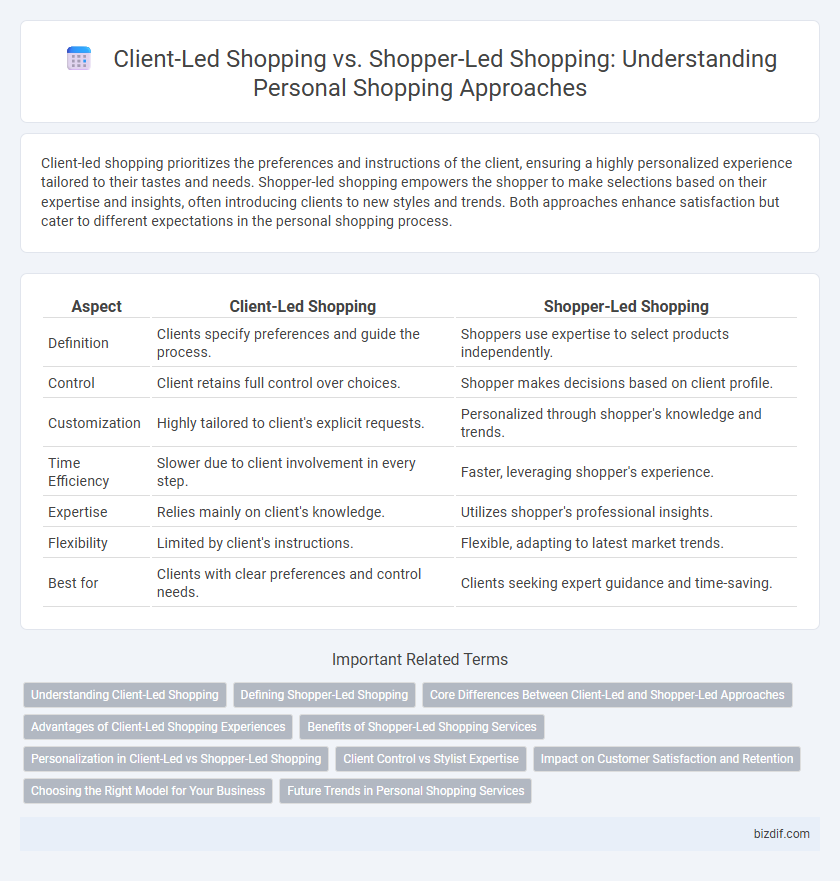Client-led shopping prioritizes the preferences and instructions of the client, ensuring a highly personalized experience tailored to their tastes and needs. Shopper-led shopping empowers the shopper to make selections based on their expertise and insights, often introducing clients to new styles and trends. Both approaches enhance satisfaction but cater to different expectations in the personal shopping process.
Table of Comparison
| Aspect | Client-Led Shopping | Shopper-Led Shopping |
|---|---|---|
| Definition | Clients specify preferences and guide the process. | Shoppers use expertise to select products independently. |
| Control | Client retains full control over choices. | Shopper makes decisions based on client profile. |
| Customization | Highly tailored to client's explicit requests. | Personalized through shopper's knowledge and trends. |
| Time Efficiency | Slower due to client involvement in every step. | Faster, leveraging shopper's experience. |
| Expertise | Relies mainly on client's knowledge. | Utilizes shopper's professional insights. |
| Flexibility | Limited by client's instructions. | Flexible, adapting to latest market trends. |
| Best for | Clients with clear preferences and control needs. | Clients seeking expert guidance and time-saving. |
Understanding Client-Led Shopping
Client-led shopping centers the purchasing process around the client's preferences, needs, and feedback, ensuring a personalized and tailored shopping experience. This approach leverages data on client behavior, style, and budget to curate product selections that resonate with the individual shopper. Emphasizing client-led shopping enhances satisfaction, loyalty, and overall effectiveness in personal shopping services.
Defining Shopper-Led Shopping
Shopper-led shopping centers on empowering clients to actively guide their purchasing decisions based on personal preferences, styles, and needs. This approach emphasizes a collaborative experience where shoppers explore options independently or with minimal assistance, fostering autonomy and satisfaction. By prioritizing the shopper's input, retailers can tailor recommendations while enhancing engagement and confidence in the buying process.
Core Differences Between Client-Led and Shopper-Led Approaches
Client-led shopping centers on the client's specific preferences and needs, guiding product selection through detailed consultations and personalized recommendations. Shopper-led shopping emphasizes autonomy, allowing customers to explore products independently and make choices based on their own insights and spontaneous interests. Core differences lie in the level of guidance--client-led provides structured support and tailored experiences, while shopper-led fosters empowerment and self-directed discovery.
Advantages of Client-Led Shopping Experiences
Client-led shopping experiences empower individuals to make informed decisions by prioritizing their specific needs and preferences, resulting in highly personalized product selections. This approach enhances customer satisfaction and loyalty through tailored recommendations and customized service. Emphasizing client input allows retailers to build stronger relationships and improve overall shopping efficiency.
Benefits of Shopper-Led Shopping Services
Shopper-led shopping services offer personalized expertise, enabling clients to access curated selections tailored to their tastes and needs. Professional shoppers leverage market knowledge and trends to save clients time while ensuring high-quality purchases. This approach enhances convenience and satisfaction by providing efficient, informed decision-making in personal shopping.
Personalization in Client-Led vs Shopper-Led Shopping
Client-led shopping prioritizes personalization by tailoring selections directly to the client's unique preferences, lifestyle, and feedback, resulting in highly customized product recommendations. Shopper-led shopping tends to rely on the shopper's expertise and judgment, which may limit tailored personalization but leverages professional insight to guide purchases. Data-driven client profiles in client-led shopping enable more precise adaptive experiences compared to the broader approach in shopper-led methods.
Client Control vs Stylist Expertise
Client-led shopping emphasizes client control, allowing individuals to direct the selection process based on their unique preferences, needs, and lifestyle, ensuring personalized satisfaction. Shopper-led shopping relies heavily on stylist expertise, where professionals apply trend knowledge, fashion insights, and experience to curate choices that clients might not discover independently. Balancing client control with stylist expertise enhances the personal shopping experience by merging individual taste with expert recommendations.
Impact on Customer Satisfaction and Retention
Client-led shopping enhances customer satisfaction by tailoring the experience directly to individual preferences, resulting in higher retention rates through personalized engagement. Shopper-led shopping offers convenience and expert recommendations, but may risk misalignment with customer desires, potentially impacting satisfaction negatively. Data indicates that integrating client input with shopper expertise maximizes loyalty and repeat business by balancing personalization and professional guidance.
Choosing the Right Model for Your Business
Choosing the right model between client-led shopping and shopper-led shopping depends on your business goals and customer engagement preferences. Client-led shopping offers personalized experiences driven by customer input, enhancing satisfaction and loyalty, whereas shopper-led shopping empowers sales professionals to guide purchases based on expertise, improving upselling opportunities and efficiency. Aligning the model with your target audience and operational strengths maximizes sales performance and customer retention.
Future Trends in Personal Shopping Services
Client-led shopping emphasizes personalized experiences driven by individual preferences and data insights, enabling tailored product recommendations through AI and predictive analytics. Shopper-led shopping leverages customer autonomy and interactive technologies like augmented reality and virtual try-ons to enhance engagement and decision-making. Future trends highlight a hybrid model combining hyper-personalization with immersive digital tools, creating seamless omnichannel experiences that anticipate evolving consumer behaviors and preferences.
Client-led shopping vs Shopper-led shopping Infographic

 bizdif.com
bizdif.com